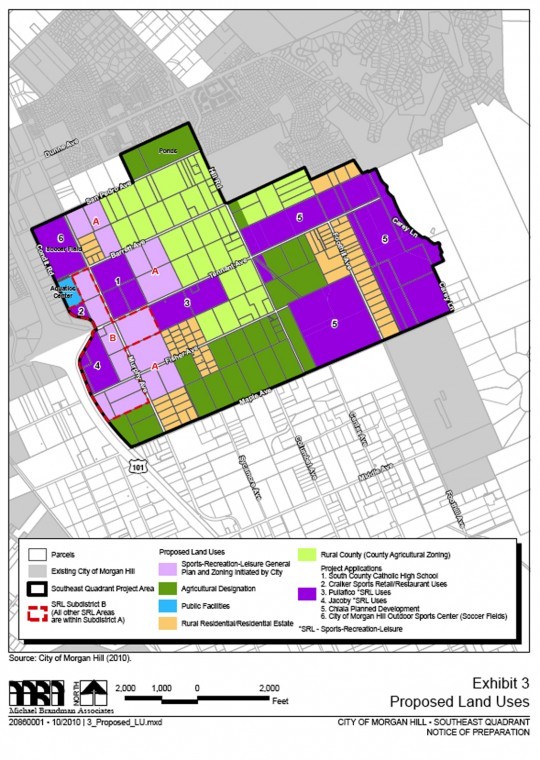The long-anticipated draft environmental review of the City’s proposed plans for the Morgan Hill Southeast Quadrant was published on City’s website Friday afternoon.
The voluminous document lists the many potential impacts of the City’s plan to extend the City limits and urban service area into the roughly 1,200-acre area on the east side of U.S. 101, which is generally bound by the freeway, Condit Road, San Pedro Avenue, Carey Avenue and Maple Avenue.
The draft Environmental Impact Report released Friday considers the City’s proposed agricultural lands preservation program, general plan and zoning amendments and boundary adjustments in the SEQ. The City wants to annex about 660 acres of the SEQ.
One developer who has already committed to a project in the SEQ is the Diocese of San Jose, who plans to build South County Catholic High School on about 40 acres of mostly undeveloped land along Murphy Avenue, between Barrett and Murphy avenues. That campus will be build in phases with extensive academic facilities as well as a number of sports fields, according to the SCCHS website.
The Diocese purchased the property for the school last year.
The City’s goal in the SEQ is to preserve agricultural land and open space, while introducing zoning for more sports, recreation and leisure uses, according to City officials. This plan has been under consideration by the City and residents for more than 10 years – since the last time the City updated its General Plan.
“It is a huge step going forward, finalizing the one quadrant that wasn’t planned in terms of open space,” said Mayor Steve Tate. “I think of it as more of a Southeast Preservation Plan, to preserve as much active agriculture as we possibly can. What’s not active agriculture, we want to be as open as possible so the recreation and leisure overlay will play to that, and the fields at the Catholic high school will play into that.”
The SEQ is currently in Santa Clara County’s land use jurisdiction. Land uses there now include the City’s Outdoor Sports Complex, and low-density residential developments.
Longtime Morgan Hill developer Gordon Jacoby has kept an eye on the City’s plans for the SEQ for more than 10 years. He recently represented the owner of about a 25-acre parcel in a pending deal with the City, who wants to purchase the property for a baseball and softball field complex. That property is also in the SEQ, just south of the intersection of Tennant and Murphy avenues.
Jacoby said the City’s SEQ plan is “unique” to almost any other city or county in its effort to preserve undeveloped spaces the way they are.
“We’re dealing with only a handful of farmers that remain in Morgan Hill that farm on 5 to 30-acres (each), and they’re having to compete with folks in San Joaquin Valley and Salinas,” Jacoby said. “(The SEQ plan) deals with the economics of trying to balance things so the farmers can compete. It creates a zone to get conservation money. It is a totally different plan than is done elsewhere. Other cities have been big on housing development or industrial.”
Although Jacoby, who has years of experience commissioning and reading environmental reports, had not completed the massive document by Friday afternoon, he said the impacts of the SEQ plans identified in the document that he’s glanced over are “fairly slight.”
“This is a plan to try to incentivize farmers to stay around,” Jacoby said.
Complementing the EIR is the City’s proposed Agricultural Mitigation Policy, which is also in the review process. City staff hope to have the mitigation policy approved before the EIR, according to Morgan Hill Community Development Director Andrew Crabtree. That policy will require future developers to offset their elimination of open space by paying a fee to purchase undeveloped property elsewhere in the City for permanent preservation.
The minimum review period for public comment for the draft EIR is 45 days, but Crabtree said that will likely be extended. After that will follow a series of amendments and approvals by the City Council, leading to an eventual annexation application to the Santa Clara County Local Agency Formation Commission.
The EIR is expected to cost about $482,000 to produce. The City paid about $173,000 of that, with private developers who have proposed projects in the quadrant picking up the rest of the tab.
The draft EIR is available on the City’s website at www.morganhill.ca.gov.








